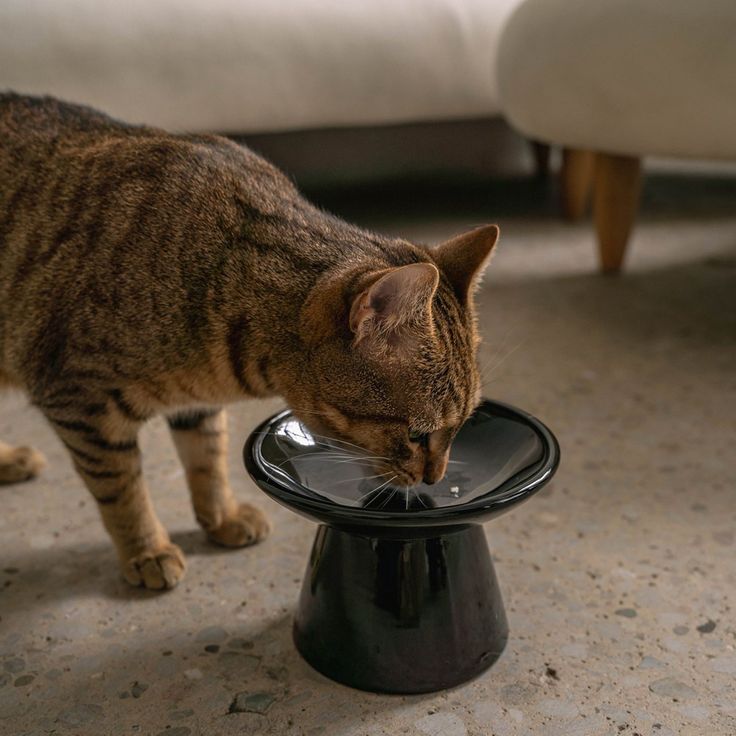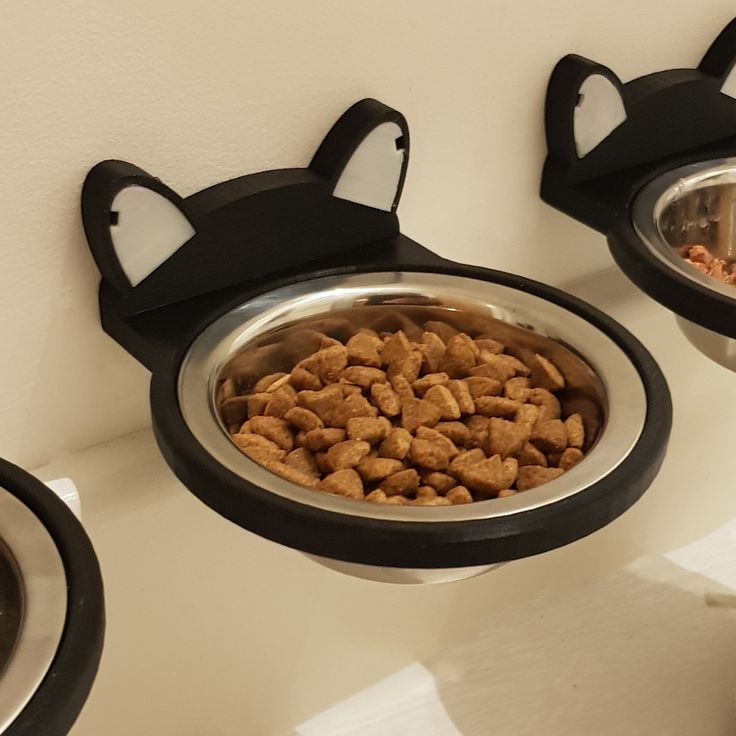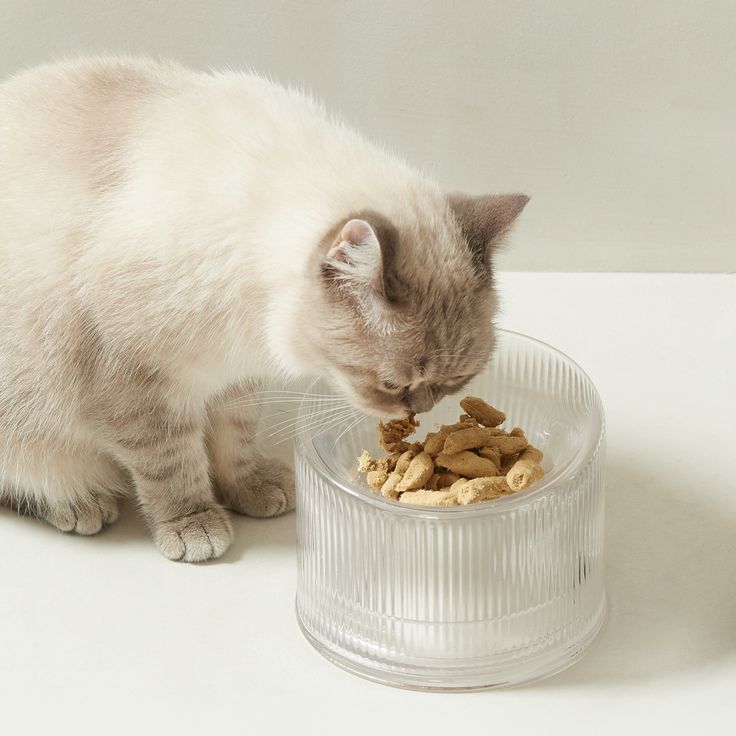In This Article
Types of Cat Bowls
Selecting the best cat bowls involves looking at the different types available. Each material has its own pros and cons. Here’s a brief overview.

Ceramic Bowls
Ceramic bowls are popular among cat owners. They come in various designs, adding a touch of style to your pet’s dining area. These bowls are generally heavy, which helps prevent tipping and sliding. They are also easy to clean. However, ceramic can chip or break if dropped, potentially creating sharp edges that could harm your cat. Always inspect ceramic bowls regularly for damage.
Stainless Steel Bowls
Stainless steel bowls are highly durable and resistant to rust and scratching. They’re a sanitary option because they do not harbor bacteria as easily as other materials. Most are dishwasher-safe, making cleanup a breeze. They also tend to have a longer lifespan than other types of bowls. But, they may slide on smooth floors unless they come with rubber or silicone bases.
Plastic Bowls
Plastic bowls are lightweight and inexpensive. They come in a variety of colors and sizes. However, they are prone to scratching, which can harbor harmful bacteria over time. Also, some cats may develop an allergy to plastic, which can lead to skin problems around the face. If you opt for plastic, be sure to replace them if they show signs of wear.
Automatic Feeding Bowls
For busy cat owners, automatic feeding bowls are a convenient choice. They can dispense food at preset times, ensuring your cat sticks to a feeding schedule. Some even come with the ability to record your voice to call your cat for meal times. Though they are practical, these bowls still require regular cleaning to maintain hygiene. Battery or power failures can also disrupt your cat’s feeding routine, so keep an eye on the functioning of these devices.
Key Features to Consider
When selecting the best cat bowls, several key features must be considered to ensure the comfort and health of your cat. These features not only impact the daily use but also contribute to the overall wellness of your feline friend.
Bowl Size and Depth
Choosing the right size and depth of the bowl is crucial. Cats prefer shallow bowls that do not interfere with their whiskers. Deep bowls may cause discomfort and deter your cat from eating properly. Make sure the bowl is large enough to accommodate the portion sizes without overcrowding.
Non-Skid Features
Cats tend to push their bowls while eating. Bowls with non-skid features such as rubber bases help prevent slipping and sliding on the floor. This stability is important as it encourages cats to eat without distraction or frustration.
Durability and Ease of Cleaning
The best cat bowls are durable and easy to clean. Stainless steel bowls, for example, are robust and dishwasher-safe, making them a practical choice. Avoid bowls with complex designs that might trap food particles and bacteria.
Compatibility with Cat’s Eating Habits
Observe your cat’s eating habits before choosing a bowl. Some cats eat quickly and might need a slow-feeder bowl, while others might prefer a flat dish. Tailoring the bowl to your cat’s preferences can prevent issues like vomiting or indigestion.
Health Implications
Choosing the best cat bowls also means considering the health implications for your feline friend.
Importance of Bowl Material
The material of your cat’s bowl plays a key role in their health. Non-toxic, non-porous materials like stainless steel prevent bacteria growth. Avoid materials that chip easily or can cause allergies, which could affect your cat’s well-being.
Positioning and Height of Bowls
The right positioning and height can prevent neck strain and improve your cat’s posture while eating. Elevated bowls can aid digestion and comfort, especially for older cats with arthritis.
Frequency of Cleaning
Regular cleaning is vital to prevent the build-up of bacteria and food residue. Clean the bowls daily and inspect them for signs of wear or damage which could harm your cat.
Latest Trends in Cat Bowls
As cat owners seek better ways to care for their pets, the cat bowl market evolves. Here are the latest trends.
Smart Bowls: Technology Integration
Smart bowls are changing the game. These bowls track your cat’s eating habits and adjust feeding amounts. Some sync with phone apps to monitor health data. This tech makes it easier to prevent obesity and overfeeding. Look for features like weight sensors and mobile notifications in the best cat bowls with smart technology.
Eco-Friendly Options
Eco-conscious owners now have options. Bowls made from recycled materials or sustainable sources are trending. They offer a way to take care of your cat and the planet. Bamboo, recycled glass, and stainless steel are popular choices. Consider these materials when you search for the best cat bowls with low environmental impact.
Customizable and Personalized Bowls
Lastly, bowls that match your style are on the rise. Owners can order bowls with their cat’s name, or designs that fit home decor. These options make feeding your cat a more personal experience. Look for services that provide custom engraving or printing when choosing the best cat bowls to add a personal touch.

How to Transition to a New Bowl
Transitioning to a new bowl can be a delicate process for cats. They can be particular about their feeding spots and dishes. To help your cat adjust to a new bowl, it is important to make changes gradually.
Introducing New Bowls Gradually
Start by placing the new bowl next to the old one. Fill both with a small amount of food. This lets your cat explore the new bowl without feeling forced. Gradually increase the food in the new bowl while decreasing it in the old one. Over several days, your cat should become more comfortable with the change. Patience is key during this transition.
Observing Cat’s Behavior With New Bowl
Watch your cat closely as they interact with the new bowl. Look for signs of acceptance or discomfort. A cat that’s at ease will eat regularly without hesitation. If the cat is wary, it may approach the bowl, sniff it, and walk away. This behavior is normal but needs monitoring. If your cat refuses to eat from the new bowl for an extended period, consider a different style or material that may be more appealing.
Adjustments Based on Cat’s Reaction
If your cat shows signs of discomfort, it’s best to slow down the transition. You may need to revert to the old bowl temporarily. When trying again, ensure the new bowl has desirable features. If it’s too deep, try a shallower one to avoid whisker fatigue. An anti-skid base can also help if the bowl moves too much. Adjusting to your cat’s preferences is crucial for a smooth transition. Remember, the best cat bowls make your cat’s dining experience pleasant and stress-free.

Best Practices for Bowl Maintenance
Maintaining your cat’s bowl is essential for their health and happiness. Here’s how to keep them in top shape.
Regular Cleaning Schedule
Establish a daily cleaning routine for the best cat bowls. After each meal, rinse the bowls with hot water and wipe them down to remove food debris. Weekly, wash them with soap and warm water for a thorough cleanse. Sticking to this schedule will prevent bacteria from building up.
Suitable Cleaning Agents and Techniques
Use gentle cleaning agents designed for pet dishes. Harsh chemicals can leave harmful residues. For scrubbing, choose non-abrasive sponges or brushes to avoid scratching the bowls, which could harbor bacteria. Dishwashers are ideal for stainless steel bowls, but avoid using them for plastic bowls that could warp.
Replacement Frequency
Inspect bowls regularly for signs of wear, such as cracks, chips, or deep scratches. For the safety of your cat, replace plastic bowls every year and ceramic ones if you see any damage. Stainless steel bowls have a longer life but should be replaced if they get dented or rusted. These best practices ensure your cat bowls remain safe and hygienic.
Where to Purchase Cat Bowls
Finding the best cat bowls for your feline friend involves knowing where to shop. You have two primary options: pet stores and online retailers.
Pet Stores vs. Online Options
Pet stores offer the benefit of seeing products up close. You can feel the quality and check for flaws. Staff can also offer advice based on your cat’s specific needs. However, pet stores may have limited options compared to online.
Online shopping provides convenience and variety. It’s easy to compare prices and read customer reviews. You often find better deals and unique bowls that aren’t available locally. But, you can’t physically check the products before buying. Always ensure online sources are reputable to avoid scams.
Things to Look for When Buying Online
When purchasing the best cat bowls online, keep these tips in mind:
- Read product descriptions carefully; check materials and dimensions.
- Look for clear, high-quality images to view the bowl’s design and features.
- Read customer reviews for insights into the product’s real-world performance.
- Verify the website’s return policy, in case the bowl isn’t what you expected.
- Check for secure payment options to protect your financial information.
By considering these factors, you can confidently choose the best cat bowls for your pet, whether you shop at a physical store or online.